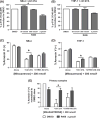Stromal CYR61 Confers Resistance to Mitoxantrone via Spleen Tyrosine Kinase Activation in Human Acute Myeloid Leukaemia
- PMID: 25974135
- PMCID: PMC5490799
- DOI: 10.1111/bjh.13492
Stromal CYR61 Confers Resistance to Mitoxantrone via Spleen Tyrosine Kinase Activation in Human Acute Myeloid Leukaemia
Abstract
Approximately 50% of children with acute myeloid leukaemia (AML) relapse, despite aggressive chemotherapy. The bone marrow stromal environment protects leukaemia cells from chemotherapy (i.e., stroma-induced chemoresistance), eventually leading to recurrence. Our goal is to delineate the mechanisms underlying stroma-mediated chemoresistance in AML. We used two human bone marrow stromal cell lines, HS-5 and HS-27A, which are equally effective in protecting AML cells from chemotherapy-induced apoptosis in AML-stromal co-cultures. We found that CYR61 was highly expressed by stromal cells, and was upregulated in AML cells by both stromal cell lines. CYR61 is a secreted matricellular protein and is associated with cell-intrinsic chemoresistance in other malignancies. Here, we show that blocking stromal CYR61 activity, by neutralization or RNAi, increased mitoxantrone-induced apoptosis in AML cells in AML-stromal co-cultures, providing functional evidence for its role in stroma-mediated chemoresistance. Further, we found that spleen tyrosine kinase (SYK) mediates CYR61 signalling. Exposure to stroma increased SYK expression and activation in AML cells, and this increase required CYR61. SYK inhibition reduced stroma-dependent mitoxantrone resistance in the presence of CYR61, but not in its absence. Therefore, SYK is downstream of CYR61 and contributes to CYR61-mediated mitoxantrone resistance. The CYR61-SYK pathway represents a potential target for reducing stroma-induced chemoresistance.
Keywords: adhesion; drug resistance; marrow stroma; myeloid leukaemia; signalling.
© 2015 John Wiley & Sons Ltd.
Conflict of interest statement
The authors have no competing interests.
Figures








References
-
- Braselmann S, Taylor V, Zhao H, Wang S, Sylvain C, Baluom M, Qu K, Herlaar E, Lau A, Young C, Wong BR, Lovell S, Sun T, Park G, Argade A, Jurcevic S, Pine P, Singh R, Grossbard EB, Payan DG, Masuda ES. R406, an orally available spleen tyrosine kinase inhibitor blocks fc receptor signaling and reduces immune complex-mediated inflammation. Journal of Pharmacology and Experimental Therapeutics. 2006;319:998–1008. - PubMed
-
- Gamis AS, Alonzo TA, Meshinchi S, Sung L, Gerbing RB, Raimondi SC, Hirsch BA, Kahwash SB, Heerema-McKenney A, Winter L, Glick K, Davies SM, Byron P, Smith FO, Aplenc R. Gemtuzumab ozogamicin in children and adolescents with de novo acute myeloid leukemia improves event-free survival by reducing relapse risk: results from the randomized phase III Children’s Oncology Group Trial AAML0531. Journal of Clinical Oncology. 2014;32:3021–3032. - PMC - PubMed
-
- Gradler U, Schwarz D, Dresing V, Musil D, Bomke J, Frech M, Greiner H, Jakel S, Rysiok T, Muller-Pompalla D, Wegener A. Structural and biophysical characterization of the Syk activation switch. Journal of Molecular Biology. 2013;425:309–333. - PubMed
Publication types
MeSH terms
Substances
Grants and funding
LinkOut - more resources
Full Text Sources
Other Literature Sources
Medical
Miscellaneous

